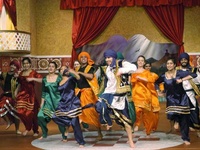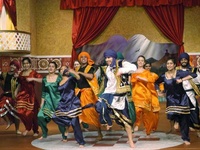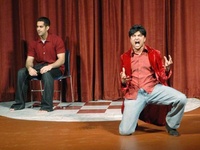Wielding twirling sticks and poking fun at the overachieving and overpopulated subcontinent, the cast and crew of the 15th annual production of the Harvard South Asian Association’s cultural show, Ghungroo, performed to sold-out audiences at the Agassiz Theatre over Junior Parents’ Weekend, March 4-6.
According to producer Saritha Komatireddy ’05, who is also a Crimson editor, in her producer’s speech following the intermission, the show was put on by over 130 students, who danced, choreographed, sang, recited poetry and composed original songs and skits for a full evening of entertainment and cultural education.
The show capitalized on its large talent pool—diverse both in experience and in ethnicity—to create a representative depiction of cultures within South Asia and the Diaspora.
For co-producer Vinod E. Nambudiri ’05, the goal of Ghungroo is to pique audience members’ interest in South Asian art and culture so that they might pursue these interests in greater depth.
“We hope to provide a glimpse into the arts in South Asia, and [we] realize that for the audience, we’re only able to provide a small sampling,” he said.
HIGH PERFORMANCE
Distinctive to the show is the sense of community among performers, who often participate in the annual extravaganza for all four of their undergraduate years. Ghungroo’s cast draws on a mix of undergraduates, some of whom have been receiving training in South Asian dance and music since childhood. Others are just starting to get involved in the South Asian community through the biggest cultural show of the year housed in the Agassiz Theatre.
Performers include regulars to the Harvard theater scene, such as Rupak Battacharya ’05, whose acting know-how stole scenes and brought roaring laughter and applause from the audience. Battacharya says he was first captivated by Ghungroo as an awe-inspired sixth-grader who came to see his older brother Mallar Battacharya ’98 perform in the show. He said he was wowed by the cleverness of the skits and, even at the tender age of 11, knew he wanted to be a part of the action someday.
Compared to some of his other work acting in productions at Harvard and in the Boston-area, Battacharaya says there’s a livelier, more personable chemistry between actors during Ghungroo. In some other shows, he says, “people are onstage and dead, they aren’t talking to each other, but at each other.”
But throughout Ghungroo, the onstage antics and the excitement of the performers themselves was evident. Audience members frequently shouted out encouragement to their friends on stage, and even clapped when performers recovered from a momentary bobble.
“There were times when we were on the brink of laughing, and some of us did crack sometimes, even though we weren’t supposed to,” Barracharya says. “But, you know, that’s what it’s all about.”
Shawn S. Baldini ’04, a four-year veteran of Ghungroo, who composed the evening’s skits along with Vijay S. Ganesh ’04, used his experience as a staff writer for the Harvard Lampoon—that semi-secret Sorrento Square social organization that used to occasionally publish a so-called humor magazine—to facilitate the on-stage antics between actors. His skits poke fun at South Asian stereotypes—Medical students or NGO-bound achievers with nagging mothers and painkiller addictions.
“That’s always the starting point for these skits—these are Indian people, Indian immigrants, children of Indian immigrants,” he says. When writing the skits, he says he asks himself, “What are the common experiences they’ve had?”
Baldini says the collaborative efforts with actors and the tech crew, which make his skits come to life, are the best part of the show—and why so many participants return year after year.
“It’s an amazing, great atmosphere,” he says of late-night rehearsals, ordering pizzas and throwing out jokes to cast-mates. “It’s just so fun to work on the dances, the skits, from beginning to end, and people become very close.”
Read more in Arts
Why Do I Keep Super Sizing Me?
















